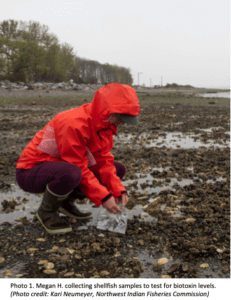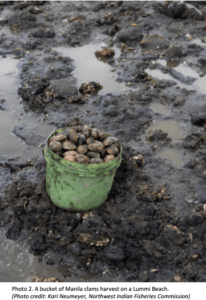Blooming Large: Tracking the Health Risks of Harmful Algae in a Tribal Community


The Salish Sea spans through what is currently known as Washington State and British Columbia and is blessed with an abundance of resources that have sustained the indigenous peoples since time immemorial. Coast Salish tribes continue to inhabit these regions harvesting important traditional foods. A common saying among Coast Salish Peoples is, “when the tide is out, the table is set,” which refers to the abundant food resources available in the intertidal. The environmental changes experienced in the Salish Sea will have significant impacts to the intertidal habitat, including the culturally and economically important shellfish species that live in the intertidal zone. Bivalve shellfish, such as clams, oysters, and mussels, are one of the important food resources available in the intertidal and are valued for ceremonial, subsistence, and commercial harvest by the Lummi Nation.
Bivalve shellfish are filter feeders, filtering large volumes of seawater consuming phytoplankton in the process. A small percentage (<1%) of phytoplankton species produce biotoxins. These naturally occurring phytoplankton species can increase rapidly creating high biomass “blooms” under certain environmental conditions known as harmful algae blooms (HAB), commonly referred to as “red tides.” When harmful algae become the abundant food source in the water the shellfish feeding on them can become temporarily toxic and unsafe for human consumption. These HAB events pose a serious threat to indigenous coastal communities and can contribute to food insecurity from loss of subsistence harvest and disruption of culture practices and community identity.


In recent years, marine HABs have undeniably increased the health risks to the Lummi People in their main shellfish harvesting areas. In particular, levels of biotoxins have increased in toxicity, new biotoxins have emerged, and biotoxin closures are lasting longer. As our climate warms, we can expect to see an increase in HAB events and biotoxin risk associated with consuming shellfish. Warming water temperatures are expected to increase algae bloom friendly conditions for longer periods of the year resulting in HABs occurring more frequently and lasting even longer. The increased health risk from biotoxins limits safe shellfish harvest opportunities for subsistence, ceremonial, and commercial purposes for the Lummi People.


With the funding granting by the National Indian Health Board (NIHB) through the Climate Ready Tribes Project, the Lummi Natural Resource Department (LNR) has been able to respond to the increased health risk. We have built capacity to respond and prepare the Lummi Nation for the increased shellfish health risks due to climate change through education outreach efforts and partnerships with local networks. We made leaps and bounds in community outreach on shellfish biotoxins by improving access to closure information, holding community outreach events, and creating a HAB brochure available to the community. These efforts included increased sampling of shellfish for biotoxin levels providing more timely and accurate harvest closures and increased access to harvest closure information by providing that information on the LNR website and installing beach harvest closure signs at access points. These efforts have continued to prepare the Lummi Nation for the increased health risks of consuming traditional food from the Lummi Reservation tidelands.
Megan Hintz is a Shellfish Biologist with the Lummi Nation. The National Indian Health Board and Climate for Health are partnering throughout November for National Native American Heritage Month to amplify Tribal leadership on climate solutions. You can learn more about NIHB’s Climate Ready Tribes Program here.